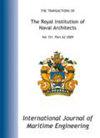船舶疏散建模的随机网络方法
IF 0.6
4区 工程技术
Q4 ENGINEERING, MARINE
引用次数: 0
摘要
本文利用多商品网络理论和图搜索技术,开发了一种新颖、高效、鲁棒的海上船舶疏散工具。MSC/1533 (IMO, 2016)为船舶疏散分析提供了简化/准高级分析方法的指南。国际海事组织的技术描述了一种规定性的方法,没有考虑与疏散环境的动态性质相关的路径可变性或不确定性。为了加强国际海事组织提出的工作,在Excel中开发并实施了一个线性规划多商品绘图解决方案。该模型基于网络理论和图论,确定了乘客的基本特征,模拟了船舶的几何形状,并指定了路径约束。模拟确定到最近的安全点/集结站的最短路线。在模拟中,采用蒙特卡罗方法来表征模型的不确定性。初步实验表明,该方法是可行的。作为一种系统工程工具,它可用于权衡研究,以确定船舶布局设计和确定路径延迟/阻塞点,并可用于对现有船舶配置的疏散性能进行排名。本文章由计算机程序翻译,如有差异,请以英文原文为准。
A Stochastic Network Approach to Modelling Ship Evacuation
This paper presents a development of a novel, efficient, and robust tool to conduct evacuation from maritime ships using multi-commodity network theory and graph search techniques. MSC/1533 (IMO, 2016) presents guidelines to conduct simplified/quasi-advanced analysis methods for the evacuation analysis of ships. The IMO techniques describe a prescriptive approach and don’t consider path variabilities or uncertainties associated with the dynamic nature of the evacuation environment. To enhance the work presented by the IMO, a linear programming multi-commodity graphing solution has been developed and implemented in Excel. This model is based on network and graph theory and specifies basic passenger characteristics, simulates ships geometry and specifies path constraints. The simulation determines the shortest route to the nearest safe point/muster station. Monte Carlo is used to characterise model uncertainties in the simulation. Initial experiments indicate this technique is feasible. As a Systems Engineering tool, it can be used in trade-off studies to finalise ship layout design and identify path delay/choke points and can be used to rank evacuation performance of existing ship configurations.
求助全文
通过发布文献求助,成功后即可免费获取论文全文。
去求助
来源期刊

International Journal of Maritime Engineering
ENGINEERING, MARINE-
CiteScore
1.20
自引率
0.00%
发文量
18
审稿时长
>12 weeks
期刊介绍:
The International Journal of Maritime Engineering (IJME) provides a forum for the reporting and discussion on technical and scientific issues associated with the design and construction of commercial marine vessels . Contributions in the form of papers and notes, together with discussion on published papers are welcomed.
 求助内容:
求助内容: 应助结果提醒方式:
应助结果提醒方式:


